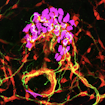
Children with autism often have behaviors that suggest problems with attention. It is unclear whether this attention deficit causes the other symptoms of autism or are a consequence of the disorder.
On 4 February, SFARI hosted a workshop to discuss the nature of differences in attention in people with autism. The participants concluded that there is an attention deficit in autism — particularly in terms of social information, that there are early differences in attention between infants and toddlers who have autism compared with controls, and that the cause and effect of attention deficit is a complex issue that requires study.
How we see:
The primary question is whether there is an attention deficit in autism.
But first, what does it mean to pay attention?
The answers to this question are many and varied. Attention includes the ability to search through a set of items to find a particular object (e.g., keys), the ability to select and respond to relevant and salient parts of a scene (e.g., small, pointy objects), and the ability to plan future actions (e.g., how to contact a locksmith if needed).
Some studies suggest that the neural mechanisms that underlie perceptual attention — how we process and subsequently remember items in our environment — may be affected in autism, Robert Desimone, director of the McGovern Institute for Brain Research at the Massachusetts Institute of Technology, said at the workshop.
When we pay attention to an item, the rhythmic activity of the neurons that process this item tend to become more synchronized in the gamma frequency range — 40 to 70 Hz. Similar patterns exist in functionally connected brain areas, which can also influence which information the brain attends to.
Gamma-aminobutyric acid, or GABA — a neurotransmitter whose function may be disrupted in autism — appears to be critical for synchronizing the firing of neurons in the gamma frequency range.
Some individuals with autism, as well as their unaffected siblings, exhibit less synchronization in the gamma frequency range than do controls. This suggests that those with autism could suffer disruptions in the circuits that synchronize neuronal activity both within and across brain regions.
What to watch:
When we pay attention to something, how do we decide what to focus on?
Several factors drive perceptual attention: It can be goal-directed (e.g., a person attends to red when looking for a red car); stimulus-driven (e.g., a person attends to a flashing dot); or it can be based on prior experience (e.g., a person attends to his or her name).
There are contradictory data on goal-directed attention in autism, noted Yuhong Jiang, associate professor of psychology at the University of Minnesota. Taken together, various studies suggest that those with autism do not have a deficit in goal-directed attention, but may differ from typically developing peers in stimulus-driven attention.
Stimulus-driven attention requires an individual to understand the demands of a task and select items and events worth attending to. Problems with stimulus-driven attention could explain some features of autism, such as avoiding eye contact or not responding to one’s name.
Studies have also suggested that people with autism have difficulty attending to the global features of a display. For example, they might have difficulty seeing that emoticons — such as 8^) — represent smiling faces.
Children with autism attend to global information when instructed to do so, but on their own, tend to notice local rather than global features, said Kami Koldewyn, a postdoctoral fellow in the laboratory of Nancy Kanwisher at the Massachusetts Institute of Technology.
Koldewyn and others presented data that suggest that at least some of the deficits in perceptual attention in autism may reflect differences in how social and nonsocial stimuli are processed. For example, children with autism are slower than controls to move their attention from a nonsocial object to a face, but quicker to shift their gaze from a face to a nonsocial object.
They also have trouble distinguishing changes in facial features — such as the distance between eyes — but are better than controls at detecting alterations in objects, such as the distance between windows, reported Jim Tanaka, professor of psychology at the University of Victoria in Canada. Their sensitivity to facial features improves after 20 hours of playing a computer game that requires them to pay attention to faces, however.
When we decide:
How do we control our attention and direct it to the most appropriate things?
In contrast with perceptual attention, executive function guides and controls three main abilities: inhibiting inappropriate behaviors, shifting attention from one task to another, and working memory, which actively holds information in memory until required.
Studies that describe executive components in autism are mixed: Many suggest that people with autism have some difficulty in planning and shifting tasks, but that working memory and inhibition are similar to those of controls.
However, studies on the development of executive function in autism are inconsistent. Many of the findings also have not been replicated, according to Elizabeth Pellicano, senior lecturer at the Centre for Research in Autism and Education at the Institute of Education in London.
The ability to understand people’s intentions is another important aspect of attention and social cognition, said Amanda Woodward, professor of psychology at the University of Chicago. Typically developing infants have some understanding of intention by 7 months of age. By 9 and 12 months of age, infants follow an actor’s eye gaze and are able to predict which object an actor will grasp.
These infants can also distinguish between people, who have intention, and objects, which do not. For example, they will assume that a hand wants a certain object, such as a bear, even if the bear’s location changes, whereas they expect a mechanical claw to always reach to the same place, regardless of the type of object it is reaching for.
There is some evidence that interventions can increase infants’ understanding of others’ intentions. For example, because toddlers love putting toys into a container, therapists can use this activity to encourage them to follow others’ actions. These interventions also may be useful for infants at risk for autism.
From attention to autism:
How early can researchers see differences in the attention profile of children who have autism?
Several workshop participants presented data that showed that how children with autism pay attention could be used as a diagnostic marker of the disorder.
Most typically developing 2-year-olds focus on certain aspects of a scene — typically the most socially interesting ones — when they watch movies of everyday events. By contrast, toddler boys with autism direct their gaze more randomly across the scene.
Using these and other eye-tracking methods, researchers are charting the overall patterns of what children with autism pay attention to, which can track development in social attention over time, reported Ami Klin, chief of autism and related disorders at Emory university in Atlanta, Georgia.
The attention patterns of children with autism start to differ from controls between 6 and 12 months of age, according to Lonnie Zwaigenbaum, associate professor of pediatrics at the University of Alberta in Canada. Infants at 12 months who are later diagnosed with autism take longer than their peers to shift their attention from an object after a second, novel object appears on the screen. They don’t show any reliable differences at 6 months old, however.
Finally, preliminary data presented by Helen Tager-Flusberg director of developmental cognitive neuroscience at Boston University, suggest that 6-month-old infant siblings of children with autism who have a high risk of developing autism differ from low-risk infants in patterns of brain waves detected by electroencephalography.
Cause or effect:
Do differences in attention result from other symptoms of autism, or are they inherent to the disorder?
This was an ongoing discussion throughout the meeting, with participants presenting data to support both sides.
Characteristics of autism such as delayed language or impaired social interaction could cause the observed attention deficits. Jiang proposed that difficulties in parsing which environmental information is important could lead to deficits in stimulus-driven attention.
Martin Raff, emeritus professor of molecular cell biology at University College London, also suggested that many of the features of autism are similar to those seen in individuals who are deprived of social interactions early in life.
Conversely, attention differences could cause the deficits in language and social interaction. Tanaka noted that children with autism spend less time looking at faces than do typically developing children, and show deficits in processing eye gaze, facial identity and facial expressions, which could influence social interactions and development.
The degree to which an individual toddler with autism looks at the same place as his typical peers can also predict his or her verbal intelligence and ability to understand and remember visual objects a year and a half later, reported Klin, suggesting that early differences in social attention are directly related to the severity of autism.
Desimone’s evidence showing that neural synchrony may be impaired in autism also suggests that basic neurological disruptions could lead to a variety of attention and learning impairments that are independent of deficits in language and social interactions.
The same questions exist for executive function. Abnormalities in language and attention could lead to deficits in executive functions, such as planning and shifting attention from one task to another, said Pellicano. In turn, executive function could also play a role in social development. For example, measures of executive function in 5-year-old children with autism predict their ability to understand others’ mental states three years later.
The workshop concluded with a brief discussion of whether the attention deficits seen in those with autism are unique to the disorder or could also be seen in people with other neurodevelopmental disorders.
The participants suggested that future research should be directed towards resolving the questions of cause and effect and developing reliable neurological measures of attention.


